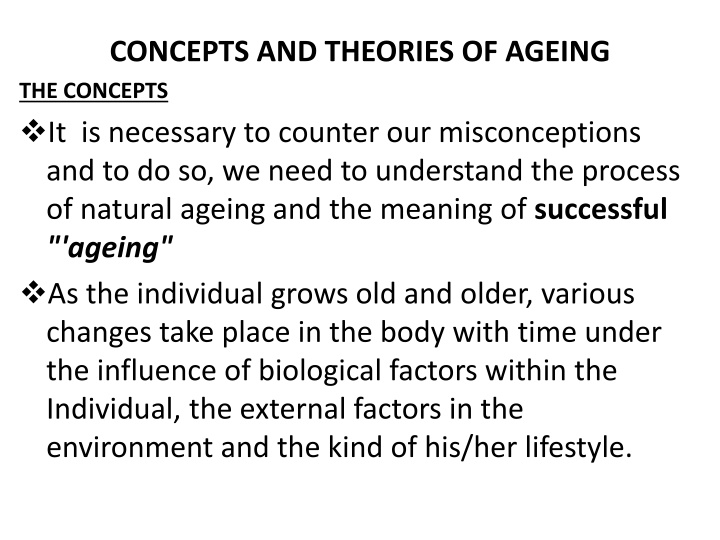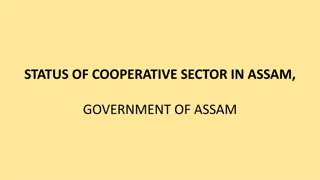
Aging Concepts and Theories: Understanding Natural Processes and Successful Aging
Explore the concepts and theories of aging, including the process of natural aging and achieving successful aging through factors like diet, exercise, and lifestyle choices. Learn about developmental theories by Erikson and Havighurst, highlighting stages and tasks in the aging process.
Download Presentation

Please find below an Image/Link to download the presentation.
The content on the website is provided AS IS for your information and personal use only. It may not be sold, licensed, or shared on other websites without obtaining consent from the author. If you encounter any issues during the download, it is possible that the publisher has removed the file from their server.
You are allowed to download the files provided on this website for personal or commercial use, subject to the condition that they are used lawfully. All files are the property of their respective owners.
The content on the website is provided AS IS for your information and personal use only. It may not be sold, licensed, or shared on other websites without obtaining consent from the author.
E N D
Presentation Transcript
CONCEPTS AND THEORIES OF AGEING THE CONCEPTS It is necessary to counter our misconceptions and to do so, we need to understand the process of natural ageing and the meaning of successful "'ageing" As the individual grows old and older, various changes take place in the body with time under the influence of biological factors within the Individual, the external factors in the environment and the kind of his/her lifestyle.
But many of the changes can be prevented and or delayed by modifying various influencing factors such as Diet, Exercise, Life style, Support system etc. leading to successful ageing. Successful ageing in other words implies healthy and Active ageing. Active ageing refers to active and disability free life. Healthy and Active ageing means: Retention of physical, physiological, psychological and social fitness to its maximum and to lead a normal life as possible like in earlier years.
Healthy and Active aging thus can be defined in terms of the ability to function autonomously within a given social setting . The older person can be healthy and active in spite of some chronic problem. Healthy and Active ageing is influenced by life time health habits, environment, social support system and emotional outlook.
THEORIES OF AGING DEVELOPMENTAL THEORIES Erikson (1963) developed the concept of eight stages of man, each stage representing crucial turning points in the life span stretching from birth to death. He delineated the major developmental task of old age as ego integrity versus despair. Ego integrity suggests an acceptance of one's lifestyle and a belief that choices made were the best that could be made at a particular time. One is still in control of one's life, a life of dignity. Despair, the opposite of ego integrity, implies that the older person feels dissatisfied and disappointed with his or her life. If given another chance, the person would live life differently.
Havighurst (1972) lists developmental tasks that occur during a lifetime. A person who completes the tasks successfully will feel contentment. These tasks of aging persons include adjusting to a decrease in physical strength and health, retirement, reduced income, and death of a spouse: establishing affiliation with one's age group; adapting to social roles in a flexible way; and establishing satisfactory physical living arrangements. A combination of these concepts results in the following tasks: (1) To maintain feelings of self-worth; (2) To resolve old conflicts; (3) To adjust to loss of power roles; (4) To adjust to the deaths of significant others; (5) To adapt to environmental changes; and (6) To maintain an optimal level of wellness.
Sociologic Theories of Aging Three major theories of aging have emerged from the scientific studies of aging conducted four and five decade ago disengement , activity, and continuity. These theories attempt to predict and explain the social interactions and roles that contribute to a successful life adjustment of a person in old age.
The disengagement theory (Curnmings & Henry, 1961) Suggests that an elderly person, by withdrawing from society at the same time that society is withdrawing its support from his or her age group, achieves high morale and life satisfaction. This theory has been refuted(disproved) by research findings showing that engaged, active persons achieve higher life satisfaction then disengaged, they are more passive people.
The activity theory (Havighurst, 1968) proposes that Life satisfaction in normal aging involves maintaining the active life style of middle age. This theory reflects the thinking it assumes that the older person will find satisfying replacements for activities.
The continuity theory (Atchley, 1989; Neugarten,) Purpose that successful adjustment to old age rests with the ability of the person to continue life patterns across a life time it is important to retain a continuity or connection to the past. Old habits, values, and interests are integral to a present life.
COGNITIVE ASPECTS OF AGING INTELLIGENCE Stereotype suggests that older people have slow thinking Process forgetfulness, confusion, and senility. Many people erroneously believe that it is difficult, if not impossible, to introduce new learning to an older adult. Intelligence tests measure the ability to accomplish intellectual task such as forming concepts, solving problems, accruing information, and reasoning.
When intelligence Test scores from of all ages are comparing test scores for older adults show a progressive decline beginning in midlife. However, studies show that environment and health have a considerable influence on scores. Interpretation of research findings is controversial. Good cardiovascular health, a stimulating environment, high levels of education, occupational status, and income all seem to have a positive effect upon intelligence scores in later life. Research studies, as well as demonstrations of creativity by older adults, show that creativity is found in all persons regardless of age. Creative performance in older adults is best manifested within a society that will provide stimulating opportunities and reward risk taking.
LEARNING AND MEMORY The ability to learn and acquire new skills and information decreases in the older adult, especially past the age of 70. Despite this, many older persons continue to learn and participate in varied educational experiences. Motivation, performance speed, ill health, and physical status all are important factors that influence learning.
Memory, an integral part of learning, has components that include short- term memory (5 to 30 seconds), recent memory (1 hour to several days), and long-term memory (lifetime). Acquisition of information, registration (recording), retention (storing), and recall (retrieval) are essential components of the memory process. Sensory losses, distractions, and disinterest interfere with acquiring and recording information. Age-related loss occurs more frequently with short-term and recent memory. In the absence of a pathologic process it is called benign forgetfulness. The process by which older adults learn is facilitated when the nurse: Supplies mnemonics to enhance recall of related data Encourages ongoing use of the intellect Links new information with familiar information





















